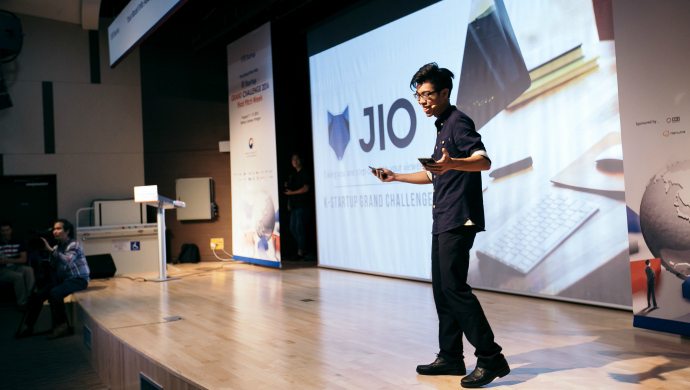The 21-year-old CEO of JIO, Benjamin Tang, skipped university to develop a startup that analyses human emotions

In mid-August this year, Benjamin Tang faced a dilemma; skip the first day of school at Singapore Management University, or attend the K-Startup Grand Challenge 2016 (an accelerator programme funded by the South Korean government).
He chose the accelerator.
Now, the 21-year-old is the CEO and Co-founder of JIO, which emerged as one of the top 40 startups out of 2,439 global competitors at the K-Startup Grand Challenge 2016.
With a workspace nestled in Pangyo Techno Valley, dubbed South Korea’s Silicon Valley, Tang is one of the youngest entrepreneurs on the programme.
The six-month-old startup is building technology to use facial feature recognition tools to enhance viewer analytics for media research.
With a core team of five members working in both Singapore and Korea, JIO uses algorithms to track a viewer’s eye movements and detect emotional changes through web cameras, which can be used to analyse emotional engagement in advertising.
A recent consumer neuroscience study by market research firm Nielsen found that emotional ads with above average electroencephalogram (EEG) scores (a measurement of electrical activity in the brain), can deliver a 23 per cent uplift in sales volume compared to average ads.
“Emotional engagement is more important in mobile advertising than traditional video advertising. If a video ad is not engaging after five seconds, viewers are just going to skip it,” Tang said.
Currently being bootstrapped by its founders, JIO’s latest facial recognition prototype, which was completed this month, can analyse videos frame by frame and detect up to seven primary emotions — such as happiness, sadness and surprise.
While JIO is currently developing enterprise solutions for advertising and media research, Tang feels that facial recognition technology has potential for more applications.
“There are IoT (Internet of Things) solutions already out there. We can use cameras to track faces and find unique people; find out who goes to work; and how many people go to shopping malls at different times of the day,” he said.
“With our technology, we can detect how these people are feeling when they are in the shops and where their eyes are looking.”
Fiona Lee, director of consumer insights at Nielsen, said that eye-tracking technologies can also be used to understand shoppers’ in-store behaviours, such as things that a shopper notices along the aisle or on the shelf.
The information can then be used to identify the ‘hot zones’ — where more shoppers look — on the shelf. These insights can be used to analyse if a retailer’s products and POS (point-of-sales) communications are engaging shoppers effectively.
JIO faces competition from emotion-tracking startups such as the Massachusetts-based Affectiva, which grew out of MIT’s Media Lab, as well as San Diego-based Emotient, which was acquired by Apple early this year.
But JIO differentiates itself with its user-friendly web application.
“Other facial recognition technologies give you their software development kits (SDK) when you use their service. But viewer research is traditionally a low-tech business. They get focus groups to watch videos, and then do surveys or interviews. They are not as familiar with SDKs,” he said.
“Our web application is easy to use, even for the non-tech-savvy. Users only need to upload a video onto the web application and they can integrate our product into their existing research.”
JIO is working with advertising and research firms like TBWA Korea and Flamingo to conduct pilot tests for its web application.
Also Read: A new ‘Beginning’: South Korea’s beSUCCESS launches platform to connect startup community
The startup, which is currently being incubated at Singapore’s Microsoft Innovation Centre, can leverage on the technology of Microsoft Singapore to improve its products, said Tang.
For example, Tang revealed that a newer eye-tracking algorithm is in the works, which will be more advanced than other traditional eye-tracking options.
“Most people track points. But our tech team has developed an algorithm for us to see zones, like hotspots, where people are looking at,” he said.
Currently, Tang has no concrete plans to return to school, and is preparing to raise an angel round to focus on developing JIO’s technology.
“Aside from primary emotions, a lot of media companies are interested in secondary emotions — like feeling inspired or motivated — so we want to conduct more research in this area,” Tang concluded.
—
The post This CEO skipped university to build JIO, an advertising technology that tracks eye movements appeared first on e27.